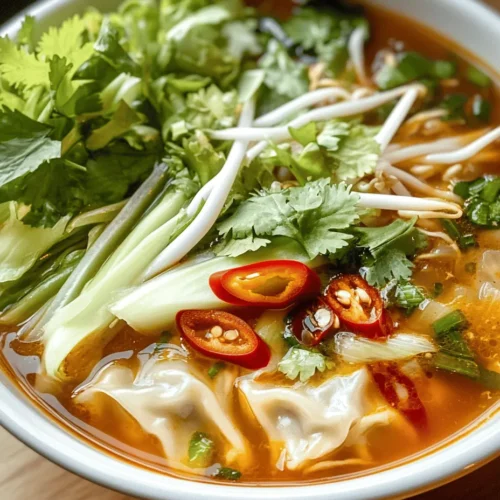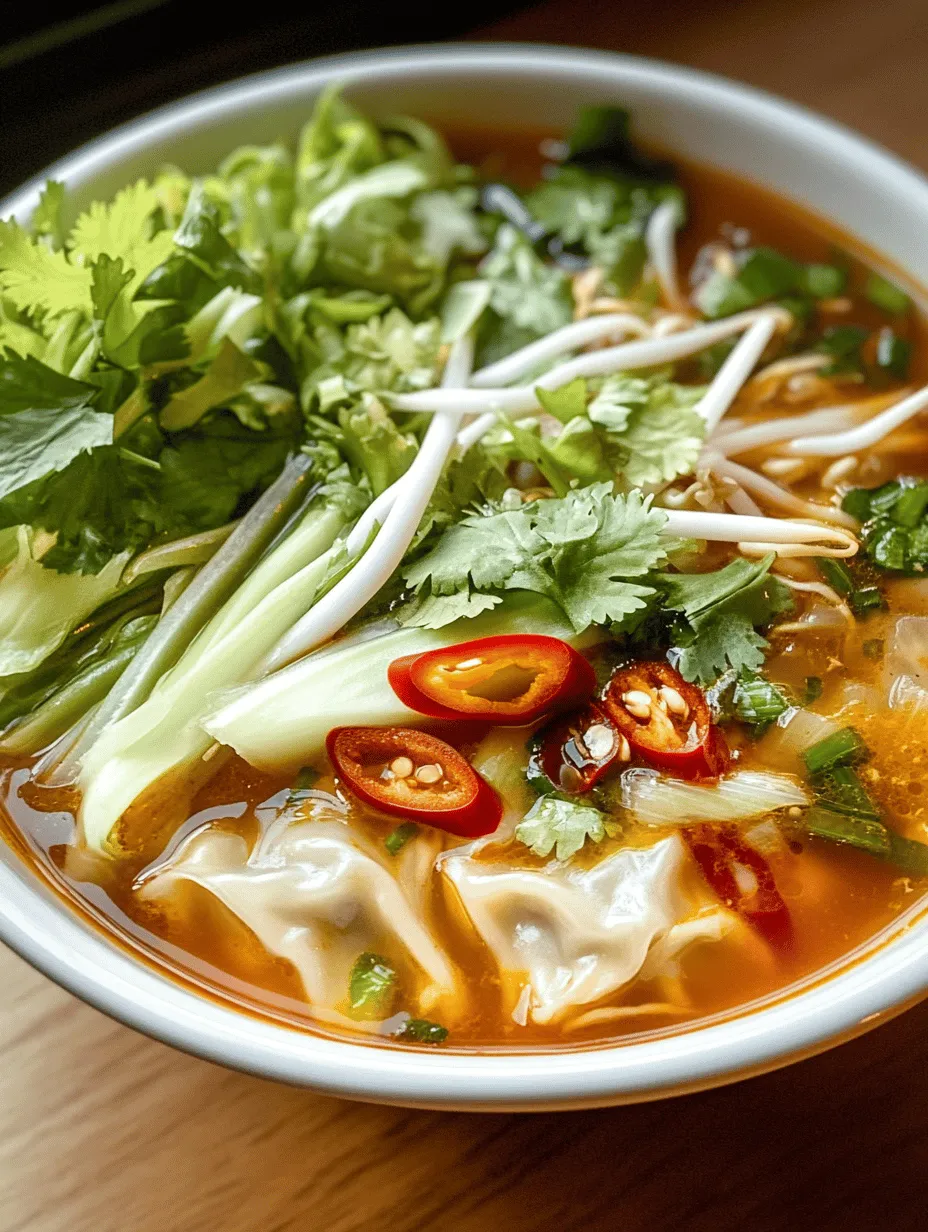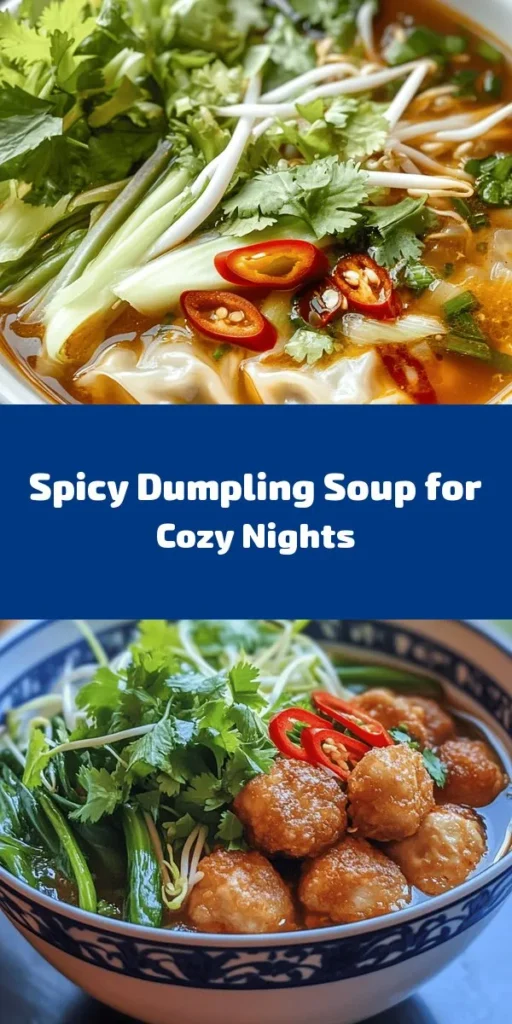Introduction
If you’ve ever found yourself craving a warm, hearty bowl of soup that not only nourishes the body but also tantalizes the taste buds, then the authentic spicy dumpling soup is a dish you must try. This comforting soup has deep roots in various cultures, particularly in Asian cuisines, where it is often served as a family favorite during chilly evenings or festive gatherings. The combination of soft, chewy dumplings filled with savory goodness, all nestled in a rich, spicy broth, creates a symphony of flavors that is both satisfying and soul-warming.
Spicy dumpling soup is more than just a meal; it embodies the spirit of sharing and togetherness. Traditionally enjoyed in homes, this dish brings families around the table, where the act of making dumplings can become a cherished ritual passed down through generations. As we dive into this recipe, you will discover how it is a perfect blend of flavor and tradition, inviting you to explore its cultural significance while indulging in its comforting embrace.
Understanding Dumpling Soup
Dumpling soup is a versatile dish that varies widely across different cultures and regions. At its core, dumpling soup can be defined as a dish featuring dumplings—pieces of dough that can be filled with meat, vegetables, or a combination thereof—served in a flavorful broth. The origins of dumpling soup can be traced back centuries, with each culture adding its unique twist to the concept. For instance, Chinese jiaozi, Korean mandu, and Italian tortellini all showcase the universal appeal of dumplings in soup.
The role of dumplings in global food culture extends beyond just being a filling ingredient. Dumplings have been a staple in many households, representing comfort and sustenance. The preparation of dumplings often involves family collaboration, making them a symbol of unity. Moreover, spices play a crucial role in enhancing the flavor profiles of dumpling soups. The warmth of spices not only elevates the taste but also adds layers of complexity, inviting you to savor every spoonful.
Ingredients Breakdown
To make an authentic spicy dumpling soup, the quality of the ingredients is paramount. Here’s a breakdown of the key components you will need for this recipe:
– Dumpling Dough: The base of your dumplings requires all-purpose flour and water. Using high-quality flour is essential for achieving the perfect chewy texture.
– Filling: The filling can vary based on personal preference, but common ingredients include ground pork or chicken, finely chopped vegetables like cabbage and scallions, ginger, and garlic. These ingredients come together to create a harmonious blend of flavors.
– Broth: A rich broth is the heart of the soup. For a spicy kick, you’ll want to include chili paste or fresh chilies, along with soy sauce and chicken or vegetable stock. The broth should be savory and aromatic, with a touch of heat.
– Garnishes: Fresh herbs like cilantro or green onions can add brightness to the dish, while sesame oil can provide a nutty finish.
Using fresh ingredients is crucial for an authentic flavor. The difference between using fresh produce versus frozen or canned can be significant, as fresh ingredients contribute to the overall taste and texture of the dish.
For those with dietary restrictions, there are several substitutions you can make. For a vegetarian version, consider using tofu or mushrooms as a filling base, combined with an array of vegetables. You can also replace traditional dumpling wrappers with gluten-free alternatives to cater to gluten sensitivities.
Making the Dumplings
The Art of Dumpling Dough: Step-by-Step Guide
Creating the perfect dumpling dough is essential for a successful dumpling soup. Start by measuring out 2 cups of all-purpose flour and placing it into a mixing bowl. Gradually add approximately ¾ cup of warm water, mixing with a wooden spoon until the dough starts to form.
1. Mixing Flour and Water: The key to a great dumpling dough is to combine the flour and water slowly. This allows the flour to fully absorb the water, preventing lumps from forming.
2. Kneading Tips for Elasticity and Smoothness: Once the dough begins to come together, transfer it to a clean, lightly floured surface. Knead the dough for about 5 to 10 minutes until it becomes smooth and elastic. This step is crucial, as the kneading develops the gluten, which gives dumplings their characteristic chewiness.
3. Resting the Dough: After kneading, cover the dough with a damp cloth or plastic wrap and let it rest for at least 30 minutes. This resting period allows the gluten to relax, making it easier to roll out later.
Preparing the Filling: Balancing Flavors and Textures
While the dough is resting, it’s time to prepare the filling. The filling is where you can really get creative, but a balance of flavors and textures is essential for the best results.
1. Choosing Your Proteins: If using meat, opt for ground pork or chicken, as they provide a flavorful base that pairs well with spices. For a vegetarian option, finely diced mushrooms or tofu can mimic the texture of meat while absorbing flavors from the seasonings.
2. Vegetables: Incorporate finely chopped vegetables such as Napa cabbage or bok choy, which are not only traditional but also add moisture and flavor to the filling.
3. Seasoning: Add minced ginger and garlic for depth of flavor, along with soy sauce, sesame oil, and a pinch of white pepper. This combination will ensure that the filling is well-seasoned and flavorful.
4. Mixing the Filling: In a large bowl, combine all filling ingredients and mix thoroughly. This is your opportunity to taste and adjust the seasoning—don’t hesitate to add more soy sauce or spices if needed.
5. Achieving the Right Flavor Profile: It’s important to balance the saltiness of the soy sauce with the natural sweetness of the vegetables. A touch of sugar can also help round out flavors, making the filling more complex.
Forming the Dumplings
Techniques for Shaping Dumplings: Traditional vs. Modern Methods
Once you have your dough and filling ready, it’s time to shape the dumplings. The technique you choose can vary based on tradition or personal preference.
1. Rolling the Dough: On a lightly floured surface, roll out the dough into a thin sheet, about 1/8 inch thick. Use a round cutter or a glass to cut out circles, approximately 3 inches in diameter.
2. Filling the Dumplings: Place a small spoonful of filling in the center of each dough circle. Be careful not to overfill, as this can make sealing difficult.
3. Sealing the Dumplings: Fold the dough over the filling to create a half-moon shape. Pinch the edges together tightly to seal, ensuring there are no air pockets inside. For a decorative touch, you can pleat the edges.
Common Mistakes to Avoid When Sealing Dumplings
– Overfilling: As mentioned, too much filling can cause the dumpling to burst while cooking. Aim for about a tablespoon of filling per dumpling.
– Not Sealing Properly: Ensure that the edges are well-sealed to prevent leakage during cooking. You can wet the edges of the dough with a little water before sealing if necessary.
– Rushing the Process: Take your time to carefully shape and seal each dumpling. This not only affects the appearance but also the cooking quality.
With your dumplings now formed, you are ready to move on to crafting the soup base that will elevate this dish to new heights. The next stage involves creating a flavorful broth that will complement the dumplings beautifully, ensuring a satisfying meal that is as delicious as it is comforting.

The Significance of Broth in Dumpling Soup
In any dumpling soup, the broth serves as the backbone of the dish, providing not only flavor but also a comforting element that brings the entire meal together. A well-crafted broth enhances the dumplings, allowing their flavors to meld and shine, creating a delicious harmony. The significance of broth in dumpling soup cannot be overstated; it is what distinguishes a good soup from an exceptional one.
To create a rich and flavorful soup base, it’s essential to use high-quality ingredients. Start with a foundation of homemade or store-bought chicken, beef, or vegetable stock. Simmering your stock with aromatics like ginger, garlic, and onions infuses the broth with an inviting depth of flavor. Incorporating spices such as star anise, cloves, and peppercorns can elevate your broth, adding layers of complexity that make each spoonful irresistible.
How to Create a Rich and Flavorful Soup Base
Begin by heating a tablespoon of vegetable oil in a large pot over medium heat. Add finely chopped ginger and garlic, stirring them until fragrant. Next, pour in your stock and bring it to a gentle boil. Enhance the flavor by adding soy sauce and chili paste, adjusting the quantities to suit your taste. Soy sauce provides a salty umami depth, while chili paste adds heat and a hint of sweetness, creating the perfect balance for your soup base.
For optimal results, allow the broth to simmer for at least 20 minutes. This simmering time is crucial as it allows the flavors to meld and intensify. As the broth simmers, taste and adjust the seasoning as needed, adding more soy sauce for saltiness or chili paste for heat. Remember, a well-seasoned broth is key to a delicious dumpling soup.
Importance of the Right Balance Between Soy Sauce and Chili Paste
Achieving the right balance between soy sauce and chili paste is critical in crafting a dumpling soup that pleases the palate. Soy sauce contributes a savory depth, while chili paste adds spice and complexity. Too much soy sauce can make the soup overly salty, while too much chili paste can overwhelm the other flavors. Aim for a harmonious blend, where each ingredient complements the others.
Start with a base of two tablespoons of soy sauce and one tablespoon of chili paste, adjusting to your preference as the broth simmers. If you’re unsure, add the chili paste gradually, tasting as you go to ensure the flavor develops without becoming overpowering. This careful balance is what will elevate your dumpling soup from ordinary to extraordinary.
Variations on the Soup Base for Heat Tolerance
If you’re cooking for a diverse crowd, consider offering variations on the soup base to accommodate different heat tolerances. For a milder version, reduce the amount of chili paste or substitute it with a touch of sweet chili sauce. This will provide flavor without overwhelming those who prefer less heat.
On the other hand, if you’re catering to spice lovers, you can amp up the heat by adding sliced fresh chilies or a dash of hot sauce. You can also incorporate Sichuan peppercorns for a unique numbing heat that adds an exciting twist. Experimenting with these variations allows you to customize your dumpling soup to suit your audience, ensuring everyone enjoys a bowl.
Cooking the Dumplings and Vegetables
Once your broth is ready, it’s time to cook the dumplings and vegetables. Properly cooking dumplings in broth is crucial for achieving the perfect texture. Gently add the dumplings to the boiling broth, ensuring they have enough space to float freely. Avoid overcrowding the pot, as this can lead to uneven cooking.
Techniques for Properly Cooking Dumplings in Broth
Cooking dumplings in broth requires a gentle touch. After adding the dumplings, stir the pot gently to prevent them from sticking to each other or the bottom. Allow the dumplings to cook for about 5-7 minutes, depending on their size and type. Frozen dumplings usually take slightly longer than fresh ones, so adjust your cooking time accordingly.
Signs of Doneness: How to Tell When Dumplings Are Cooked
To check for doneness, look for a few key signs. The dumplings should float to the surface of the broth, indicating they are cooked through. Additionally, use a slotted spoon to remove one dumpling and cut it in half. The filling should be hot and fully cooked, with no raw dough remaining. If you’re unsure, err on the side of caution and let them cook for an additional minute or two.
Incorporating Vegetables for Added Nutrition and Texture
Incorporating vegetables into your dumpling soup not only enhances the nutritional profile but also adds texture and color to the dish. Popular choices include bok choy and shiitake mushrooms, both of which bring unique flavors and health benefits.
Bok choy, with its crunchy texture and mild flavor, is an excellent addition to any soup. Simply chop it into bite-sized pieces and add it to the broth a few minutes before serving to ensure it retains its crispness. Shiitake mushrooms, known for their earthy taste, add depth to the soup. Slice them and sauté them briefly with garlic before adding them to the broth for an extra flavor boost.
Benefits of Bok Choy and Shiitake Mushrooms in Soups
Both bok choy and shiitake mushrooms are packed with nutrients. Bok choy is rich in vitamins A and C, calcium, and iron, making it a great choice for boosting your immune system and supporting overall health. Shiitake mushrooms are known for their anti-inflammatory properties and are a good source of vitamin D, which is essential for bone health. Including these ingredients in your dumpling soup not only enhances flavor but also increases its nutritional value.
Serving Suggestions
Presentation is key when serving dumpling soup. A beautifully arranged bowl can elevate the dining experience, enticing your guests before they even take a bite. Consider using a wide, shallow bowl to showcase the dumplings and vegetables.
Presentation Tips for an Appetizing Meal
When serving dumpling soup, carefully ladle the broth into each bowl, ensuring that the dumplings and vegetables are evenly distributed. A sprinkle of freshly chopped green onions or cilantro on top adds a pop of color and freshness to the dish. You can also drizzle a few drops of sesame oil over each bowl for an aromatic finish.
Recommended Garnishes and Their Flavor Contributions
Garnishes play a significant role in enhancing the flavor profile of your dumpling soup. Consider adding a handful of bean sprouts for crunch and a squeeze of lime juice for brightness. A sprinkle of crushed red pepper flakes can provide an additional layer of heat for those who enjoy a spicier kick. These simple additions can take your soup from good to great.
Ideal Pairings with Drinks or Appetizers
Dumpling soup pairs wonderfully with a variety of drinks and appetizers. For a refreshing complement, serve it alongside green tea or a light beer. If you’re looking for appetizers, consider serving spring rolls or crispy fried wontons, which can enhance the overall dining experience. The combination of flavors and textures will leave your guests satisfied and impressed.
Nutritional Information
Dumpling soup is not only delicious but also packed with nutritional benefits. The ingredients contribute to a well-rounded meal, making it suitable for various dietary needs.
Overview of the Nutritional Benefits of the Soup
The primary components of dumpling soup—broth, dumplings, and vegetables—offer a range of health benefits. The broth is hydrating and low in calories, while the dumplings provide carbohydrates and protein, depending on the filling used. The added vegetables contribute essential vitamins and minerals, making this dish a balanced option.
Caloric Breakdown and Health Benefits of Key Ingredients
A typical serving of spicy dumpling soup can range from 250 to 400 calories, depending on the number of dumplings and the types of ingredients used. For instance, a filling made with lean protein, such as chicken or tofu, will provide a healthier option compared to higher-fat meats. The vegetables in the soup add minimal calories but significant nutritional value, making it a guilt-free indulgence.
How This Soup Fits into a Balanced Diet
Incorporating spicy dumpling soup into your diet can be both satisfying and nutritious. It provides a good balance of protein, carbohydrates, and essential vitamins. When paired with a side salad or steamed vegetables, this soup becomes a complete meal that supports a healthy lifestyle.
Cultural Variations of Dumpling Soup
Dumpling soup is a beloved dish found in various cultures around the world, each with unique ingredients and preparation methods that reflect local traditions and flavors.
Exploration of Different Styles of Dumpling Soup Around the World
In Chinese cuisine, for instance, you will find wonton soup, which features delicate dumplings filled with seasoned pork or shrimp. In Polish culture, pierogi soup is a comfort food staple, often served with a rich broth and topped with crispy onions. Korean mandu-guk is another delicious variation, where dumplings are served in a savory broth with egg and green onions.
Unique Ingredients or Preparation Methods in Various Cultures
Each culture puts its own spin on dumpling soup, utilizing local ingredients and cooking techniques. For example, in Italy, ravioli is often served in broth, while in Japan, gyoza dumplings may be simmered in a miso-based soup. The versatility of dumpling soup allows for endless creativity in the kitchen, making it a dish that can be adapted to suit any palate.
Personal Anecdotes or Stories Related to Dumpling Soup from Different Regions
Many families have their own cherished recipes for dumpling soup, often passed down through generations. These recipes are imbued with personal stories, making each bowl a unique representation of family heritage. Sharing these narratives can enhance the experience of making and enjoying dumpling soup, connecting people through food.
Conclusion
Spicy dumpling soup is a comforting and flavorful dish that brings warmth and satisfaction to any meal. With its rich broth, tender dumplings, and nutritious vegetables, it is not only a feast for the senses but also a nourishing option for a balanced diet.
Making dumpling soup is a joyful experience, one that can be shared with family and friends. Whether you stick to the classic recipe or explore variations that reflect your culinary creativity, this dish has the power to become a beloved family favorite. Embrace the process of making spicy dumpling soup and enjoy the wonderful flavors and stories that come with it, celebrating the joy of cooking and sharing meals with loved ones.



